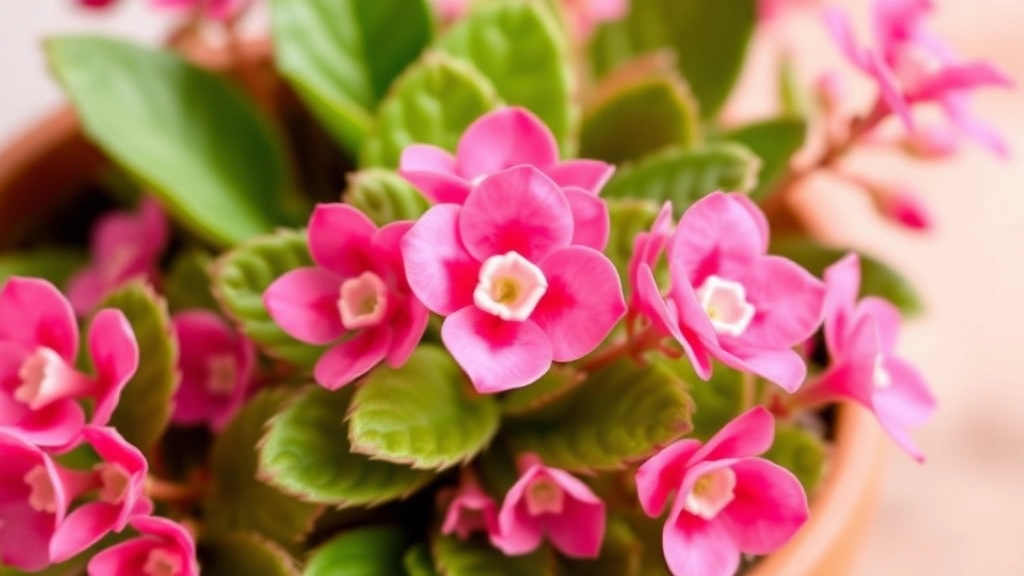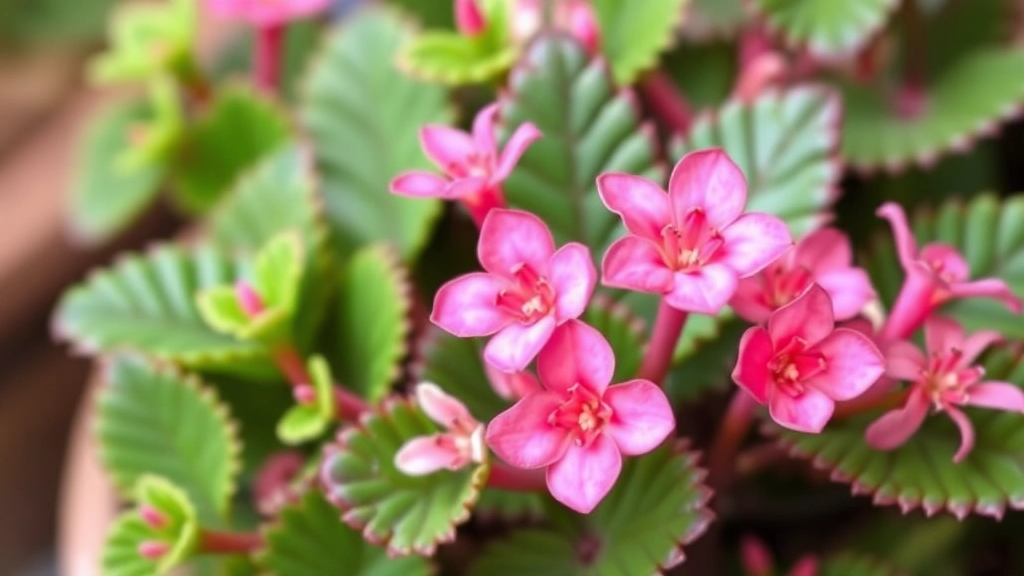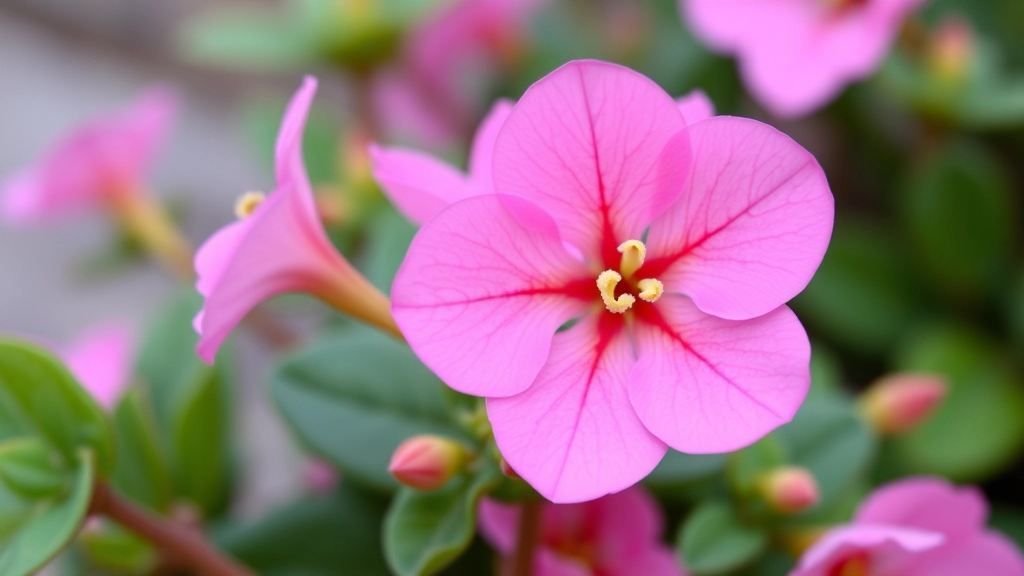Introduction to Pink Kalanchoe Flower
If you’re looking to add a splash of colour to your home or garden, the Pink Kalanchoe Flower is a fantastic choice. This vibrant succulent not only brightens up any space but is also relatively easy to care for. Whether you’re growing it indoors or outdoors, understanding the best conditions for your Pink Kalanchoe can make all the difference.
Care Tips for Pink Kalanchoe
Proper watering and fertilising techniques are crucial for keeping your Pink Kalanchoe healthy. Overwatering is a common mistake, so it’s important to let the soil dry out between waterings. Additionally, knowing how to propagate your Pink Kalanchoe from cuttings can help you expand your collection effortlessly.
Further Reading
Keep reading for more tips on tackling common care problems and creative ways to incorporate this beautiful plant into your décor.
Best Conditions for Growing Pink Kalanchoe Indoors and Outdoors
Are you struggling to get your pink kalanchoe to thrive?
Understanding the ideal conditions for growing this vibrant succulent can make all the difference.
Ideal Light Conditions
- Bright, Indirect Light: Pink kalanchoe flourishes in bright, indirect sunlight.
- Avoid Direct Sun: Too much direct sun can scorch the leaves, so position it near a window with filtered light.
Temperature and Humidity
- Temperature Range: This plant prefers temperatures between 18°C to 24°C (65°F to 75°F).
- Humidity Levels: Moderate humidity is best. If your home is too dry, consider misting the plant occasionally.
Soil Requirements
- Well-Draining Soil: Use a cactus or succulent mix to ensure proper drainage.
- pH Level: Aim for a slightly acidic to neutral pH (around 6.0 to 7.0).
Outdoor Growing Conditions
If you’re considering growing pink kalanchoe outdoors, here are some tips:
Proper Watering and Fertilizing Techniques for Pink Kalanchoe

So, you’ve got your beautiful Pink Kalanchoe and you’re wondering how to keep it thriving, right?
Watering and fertilizing are crucial parts of your plant care routine.
Watering Tips
- Frequency: Water your Pink Kalanchoe when the top inch of soil feels dry. Overwatering can lead to root rot, so it’s better to err on the side of caution.
- Method: Water deeply, allowing excess water to drain out of the pot’s drainage holes. This ensures the roots get enough moisture without sitting in soggy soil.
- Seasonal Changes: In the winter, reduce watering since the plant goes dormant. Just check that soil dryness regularly.
Fertilizing Tips
- Type of Fertilizer: Use a balanced, water-soluble fertilizer. Look for a formula with equal parts nitrogen, phosphorus, and potassium, like a 20-20-20 mix.
- Frequency: Feed your Kalanchoe every 4-6 weeks during the growing season (spring and summer). Skip the fertilizing in fall and winter.
- Dilution: Always dilute the fertilizer to half strength to prevent burning the roots.
Quick Checklist
- Water when the top inch is dry.
- Ensure proper drainage.
- Use a balanced fertilizer during the growing season.
- Dilute to half strength.
How to Propagate Pink Kalanchoe from Cuttings
Have you ever wondered how to expand your collection of Pink Kalanchoe?
Propagating this beautiful succulent is not only easy but also a rewarding experience.
Step-by-Step Guide to Propagation
- Choose the Right Time
– Spring or early summer is ideal for taking cuttings. - Select Healthy Cuttings
– Look for healthy stems with at least two to three leaves.
– Avoid any that show signs of disease or damage. - Make the Cut
– Use a clean, sharp knife or scissors to snip the cutting just below a leaf node.
– Aim for a length of about 10-15 cm. - Let it Callus
– Place the cutting in a dry, shaded area for a few days.
– This allows the cut end to form a protective callus, which helps prevent rot. - Prepare the Potting Mix
– Use a well-draining potting mix, ideally a cactus or succulent blend.
– You can also mix regular potting soil with sand or perlite for better drainage. - Planting the Cutting
– Once the cutting has callused, gently place it in the soil.
– Ensure that at least one leaf node is buried in the mix. - Water Sparingly
– After planting, water lightly to settle the soil around the cutting.
– Avoid overwatering; let the soil dry out between waterings. - Provide Proper Light
– Place the pot in a bright, indirect light location.
– Direct sunlight can scorch the cutting. - Monitor Growth
– In a few weeks, you should see new growth, indicating successful propagation.
– Once established, you can care for it like a mature Pink Kalanchoe.
By following these steps, you can easily multiply your Pink Kalanchoe plants and share them with friends or enhance your home décor. For more detailed information on caring for this beautiful plant, check out our Ultimate Guide to Growing Kalanchoe Pink Plant and our Essential Tips and Guidelines for Pink Kalanchoe Plant Care.
Common Problems and Solutions for Pink Kalanchoe Care

As we delve deeper into caring for your Pink Kalanchoe, it’s essential to address common issues that may arise. Understanding these problems can help you maintain a vibrant and healthy plant.
1. Overwatering
Symptoms:
- Yellowing leaves
- Wilting or mushy stems
Solutions:
- Allow the soil to dry out completely between waterings.
- Ensure your pot has proper drainage holes to prevent water accumulation.
2. Underwatering
Symptoms:
- Droopy leaves
- Dry, shrivelled appearance
Solutions:
- Water thoroughly when the top inch of soil feels dry.
- Consider using a moisture meter to help gauge when to water.
3. Insufficient Light
Symptoms:
- Leggy growth
- Pale leaves
Solutions:
- Place your Kalanchoe in bright, indirect sunlight.
- If indoors, a south-facing window is ideal.
4. Pest Infestations
Common Pests:
- Mealybugs
- Aphids
Solutions:
- Inspect your plant regularly for signs of pests.
- Use insecticidal soap or neem oil to treat infestations.
5. Fungal Diseases
Symptoms:
- Dark spots on leaves
- Moldy soil
Solutions:
- Ensure good air circulation around your plant.
- Avoid overhead watering to keep leaves dry.
Creative Uses of Pink Kalanchoe in Home Décor and Landscaping
When considering how to incorporate Pink Kalanchoe into your space, you might wonder how these vibrant plants can enhance your home and garden.
Indoor Décor Ideas
Pink Kalanchoe’s striking blossoms and unique foliage make it a perfect choice for indoor decoration. Here are some creative ideas:
- Accent Table Displays: Place a potted Pink Kalanchoe on a side table or console to add a pop of colour.
- Window Sills: These plants thrive in bright light, making window sills a perfect spot. Group them with other houseplants for an eye-catching arrangement.
- Hanging Baskets: Consider using hanging pots to create vertical interest. The cascading leaves can soften hard edges in your home.
- Centrepieces: Use Pink Kalanchoe in your dining room as a fresh centrepiece. Pair it with candles for an inviting atmosphere.
Outdoor Landscaping Ideas
In outdoor settings, Pink Kalanchoe can transform your garden into a vibrant oasis. Here are some suggestions:
- Rock Gardens: These plants thrive in well-drained soil, making them ideal for rock gardens. Their colours can contrast beautifully with stones.
- Border Planting: Use Pink Kalanchoe to create a colourful border along pathways or flower beds. This can lead the eye through your garden.
- Container Gardens: Mix Pink Kalanchoe with other drought-tolerant plants in containers to create stunning patio displays.
- Succulent Arrangements: Combine Pink Kalanchoe with other succulents for a low-maintenance, visually appealing arrangement.
Incorporating Pink Kalanchoe into your home and garden not only adds beauty but also brings a sense of joy and warmth. For more tips on caring for this plant, check out our guide on Pink Butterflies Kalanchoe care. Additionally, if you’re interested in expanding your succulent collection, our top Kalanchoe Mother of Thousands varieties article offers great insights.
FAQs on Pink Kalanchoe Flower Care
How often should I water my Pink Kalanchoe?
Water your Pink Kalanchoe when the top inch of soil feels dry. Overwatering can lead to root rot, so it’s better to err on the side of caution. In the winter, reduce watering since the plant goes dormant.
What is the best method for watering Pink Kalanchoe?
Water deeply, allowing excess water to drain out of the pot’s drainage holes. This ensures the roots get enough moisture without sitting in soggy soil.
What type of fertilizer should I use for Pink Kalanchoe?
Use a balanced, water-soluble fertilizer with equal parts nitrogen, phosphorus, and potassium, such as a 20-20-20 mix. Always dilute the fertilizer to half strength to prevent burning the roots.
How frequently should I fertilize my Pink Kalanchoe?
Feed your Kalanchoe every 4-6 weeks during the growing season (spring and summer). Skip fertilizing in the fall and winter.
What are common signs of overwatering?
Symptoms of overwatering include yellowing leaves and wilting or mushy stems. To fix this, allow the soil to dry out completely between waterings and ensure your pot has proper drainage holes.
How can I tell if my Pink Kalanchoe is underwatered?
Signs of underwatering include droopy leaves and a dry, shriveled appearance. Water thoroughly when the top inch of soil feels dry, and consider using a moisture meter to help gauge when to water.
What should I do if my Pink Kalanchoe is not getting enough light?
If your Kalanchoe shows leggy growth or pale leaves, it might not be getting enough light. Place your plant in bright, indirect sunlight. If indoors, a south-facing window is ideal.
How can I deal with pest infestations on my Pink Kalanchoe?
Common pests include mealybugs and aphids. Inspect your plant regularly for signs of pests and use insecticidal soap or neem oil to treat infestations.
What are the symptoms and solutions for fungal diseases?
Symptoms of fungal diseases include dark spots on leaves and moldy soil. Ensure good air circulation around your plant and avoid overhead watering to keep leaves dry.
References
-
Kalanchoe Plant Care – How To Grow A Kalanchoe
-
How to Grow Kalanchoe Indoors – The Spruce
-
Kalanchoe: How to Care for Kalanchoe Plants – The Old Farmer’s Almanac
